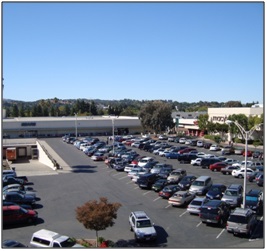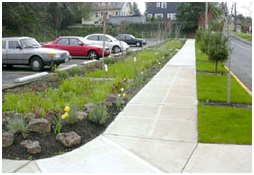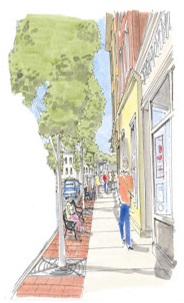Low Impact Development Site Design

Overview
Low Impact Development (LID) is a more sustainable land development approach that begins with a site planning process that first identifies critical natural resource areas for preservation. Then, once the building envelope is established, LID techniques, such as maintaining natural drainage flow paths, minimizing land clearance, clustering buildings, and reducing impervious surfaces are incorporated into the project design. A series of small stormwater best management practices (BMPs) that preserve the natural features and hydrology of the land are used instead of the conventional methods of collecting, conveying, and piping away runoff.
The Problem
Development patterns based on conventional zoning codes in Massachusetts often result in "sprawl" with its associated large impervious areas, loss of natural resources and habitat, increase in nonpoint source pollution, and alteration of hydrologic systems. Conventional developments often start with clearing and leveling of the entire parcel. Then the construction of wide, paved roads and over-designed large parking lots follow. These sprawling impervious areas eliminate vegetation (nature’s natural pollution filters), and prevent water from infiltrating into the ground (which normally replenishes groundwater supplies and supports nearby wetlands and streams with base flow). The result is the conveying of polluted runoff to water bodies In order to deal with stormwater that runs off of these sites, structural controls such as catch basins, pipes, and detention ponds are used. Instead of "greenscapes", conventional landscaping of these developments brings additional concerns including the introduction of non-native plants, use of herbicides, pesticides and fertilizers, and excessive water consumption.

Besides loss of natural resource areas, habitat corridors, and buffers to wetlands and stream, conventional development (right hand graphic) creates large areas of impervious surfaces which prevent the infiltration of rainwater. Under natural (pre-development) conditions (left hand graphic), rain infiltrates through soils and percolates downward to the underlying water table, where it recharges the groundwater. Throughout the more permeable areas of Massachusetts approximately 50% of the annual precipitation infiltrates and recharges. Groundwater serves as drinking water supply and provides base flow to streams and wetlands. This base flow is critical to habitat quality for fish and other aquatic ecosystems. In many areas of eastern Massachusetts, where watersheds have become significantly urbanized with extensive impervious areas, the base flows of streams have been diminished. In some cases, such as the Ipswich River where the stream goes dry, eliminating habitat value. Surface runoff is also increased in urbanized watersheds creating greater peak flows which can cause flooding and channel erosion.
Introduction to LID

This rain garden placed between the parking lot and sidewalk captures rainfall, allowing it to infiltrate rather than flowing onto the street.
The LID approach provides opportunities to build the homes and businesses that we need, while conserving natural areas and drainage patterns. LID is accomplished as a two-step process; FIRST-- thoughtful site planning and, SECOND--incorporation of "natural" stormwater best management practices (BMPs).
Thoughtful site planning begins with the identification of critical site features such as wetlands, habitat areas, or drinking water protection areas that should be set aside as protected open space. Natural features, such as vegetated buffers and view sheds, will also play an integral role in any LID planning exercise. After the critical open space areas are identified and set aside, sustainable development areas are then identified as "building envelopes".
Within the delineated building envelopes, a broad range of design techniques or BMPs, such as shared driveways, permeable pavers, and bioretention are used to reduce impervious cover and improve the quantity and quality of stormwater drainage. Other LID techniques include green roofs, rain barrels, rain gardens, grassed swales, stormwater infiltration systems, and alternative landscaping. Through these techniques, natural drainage pathways are conserved, open space is preserved, and the impact from development is significantly reduced.
LID techniques often provide benefits beyond those related to water and drainage. For example, green roofs also muffle noise by reducing reflective sound, mitigate "urban heat island" effects by creating microclimates that cool and humidify air in their immediate area, absorb dust and smog as well nitrates and other aerosol contaminants from air and rainfall, and generally provide natural habitat for wildlife including birds, butterflies, and insects.

These four examples of rain gardens look like conventional landscaped areas but are actually LID features that capture, treat, and slowly release rainfall to replenish local groundwater resources while beautifying parking lots, buildings, and roadways

Benefits
- Concentrate development and mix uses: The LID site planning process sets aside key natural features and focuses development into clustered patterns on the remaining land.
- Protect land and ecosystems: The reduction of impervious surfaces reduces the amount of surface runoff and through the infiltration of stormwater, recharges the groundwater system, thereby restoring the natural hydrologic cycle. This preserves groundwater supplies and base flow to streams and wetlands.
- Use natural resources wisely: The LID planning process results in housing that makes more efficient use of land and conserves critical natural features such as wetlands, vegetated buffers, and drinking water protection areas
- Increase property values: Converting or designing normally unused roof areas into green roofs can increase your property value by reclaiming that elevation of a building and make it an amenity to be used by the buildings occupants.
- Reduced energy costs: Green roofs reduce heating and cooling costs for the building between 30 - 50%, compared to buildings with conventional roofs.
Access Issues
There is a perception that LID projects may have to sacrifice good access to achieve the goal of reduced impact on natural systems. This is a real issue, but one that planners, engineers, public safety officials, and regulators can manage with careful design and common sense. Key issues and concerns include:
- Adequate street width for everyday traffic, parking, snow removal, service vehicles, and emergency vehicles;
- Adequate turning radii for school buses, service vehicles, and emergency vehicles;
- Adequate surface and structural integrity of permeable pavements for emergency vehicles; and
- Safety and maintenance of roadside swales and other surface vegetated stormwater management practices.
Key Design Elements:
- Street width needs to be correlated to traffic volume, land use, and parking demand. Residential streets with less than 500 trips per day (generally serving less than 50 houses), can be designed at a minimum width so as to accommodate a fire truck (generally as narrow as 18 to 20 feet);
- Snow removal and storage is a design component. The designer must identify where snow will be plowed, how much room might be required for snow piles, and at what level snow must be removed from street sides;
- On-street parking is a major consideration for street width and public safety. Options include parking on one side of the street only, shared travel and parking lanes for very low volume roads, or off-street visitor parking.
- Turning radii for streets and cul-de-sacs need to be designed to accommodate service and emergency vehicles. The requirements for school buses depend on the number of houses served by a street and local school district pick-up policies.
- Permeable pavements are designed to accommodate the design loading. If fire truck access is required, pavements and subgrades need to be designed accordingly. Alternative pavements, such as reinforced turf, are capable of supporting emergency vehicle travel, but special provisions may be necessary for stabilizing outriggers in the immediate vicinity of stationary vehicles.
- Roadside swales and other surface vegetated practices can be a safety issue for high volume, higher speed roads. Designers can apply a range of options such as roadside curbs with drainage slots or guard rails to protect traffic from the swale. For low volume, low speed residential roads, shallow swales represent very low risks to drivers, and sidewalks can be located on the opposite side of the swale, away from the road, to minimize risk to pedestrians.
Cost Considerations
Some critics of LID have raised the question of whether it costs more to design, implement, and maintain LID practices than it is does for conventional practices. While this is a very simple question to ask, the answer can be quite complex. First, the term "cost" must consider all costs, including: planning, design, and capital costs; long term maintenance costs; land values; and potential environmental impacts. One cannot simply assert that a practice costs less if it is less expensive to construct, since it may cost more to maintain, may result in environmental degradation, or lead to decreased property values in the long run.
This being said, costs for LID practices as well as for the conventional approach vary as a result of many factors, and generic costs cannot be easily quantified. Typical factors affecting cost include:
- Material costs;
- Site specific constraints such as access, topography, soils, groundwater, and parcel area;
- Land use;
- Location;
- Designer, reviewer, and contractor experience;
- Local regulations; and
- Overall economic climate.
The table below is offered to help planners, engineers, regulators, and developers compare the costs and benefits of LID with a more conventional land development approach.
Qualitative Cost Comparison – How LID Practices Compare with Conventional Practices
| LID Practice | Design Costs | Construction Costs | Long-Term Maintenance Costs | Increased Land Values | Decreased Environmental Impact |
| Better Site Design |  |  |  |  |  |
| Better Local Roads |  |  |  |  |  |
| Bioretention/Rain Gardens |  |  |  |  |  |
| Infiltration/Permeable Pavements |  |  (1) (1) |  (1) (1) |  |  |
| Stormwater Planters |  |  |  |  |  |
| Vegetated Swales |  |  |  |  |  |
| Vegetated Buffers |  |  |  |  |  |
| Cisterns/Rain Barrels |  |  |  (1) (1) |  |  |
| Green Roofs |  |  (1) (1) |  |  |  |
Key :
 LID practice compares favorably with conventional approach (e.g., costs less) LID practice compares favorably with conventional approach (e.g., costs less)
 LID practice compares unfavorably with conventional approach (e.g., costs more) LID practice compares unfavorably with conventional approach (e.g., costs more)
 Too close to determine, site conditions or other factors may affect cost Too close to determine, site conditions or other factors may affect cost
(1) - Costs may be too close to call, or even favorable when all costs such as heating, cooling, roof
replacement, irrigation, or additional downstream detention are considered.
|
Financial Considerations
- LID provides important benefits to the municipality, the developer, and the general public. More concentrated (cluster) design, with less impervious area and smaller infrastructure (stormwater drainage and other utilities), means significant cost savings to developers and reduces maintenance costs for municipalities.
- LID reduces demand on public stormwater infrastructure. LID reduces the amount of water that flows into public storm sewers; the result is fewer combined sewer overflows and expenditures on maintenance and capital improvements.
- LID promotes recharge to and the preservation of aquifers thereby reducing the need for and high cost of providing additional public water supply sources.
- LID reduces non-point source pollution to drinking water supplies, recreational waters, and wetlands, saving future expenditures for restoration of valuable water resources.
- LID reduces building costs. A green roof protects the roof membrane from climatic extremes and physical abuse, thereby greatly increasing the life expectancy of the roof - typically up to 40 years.